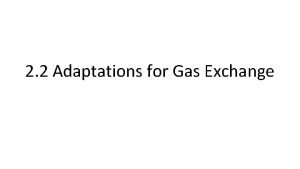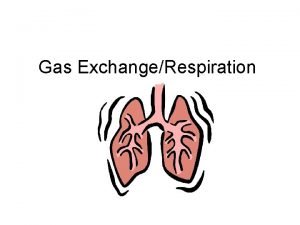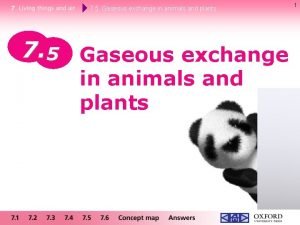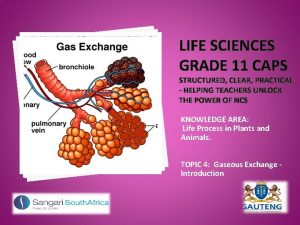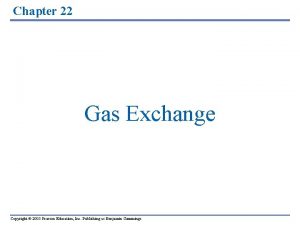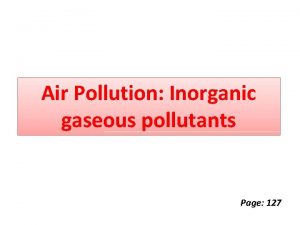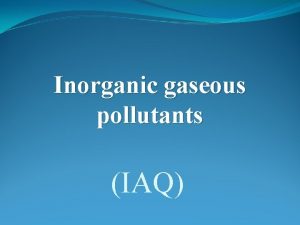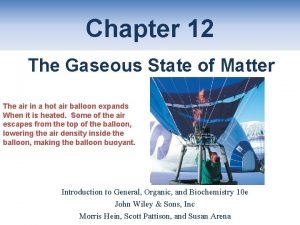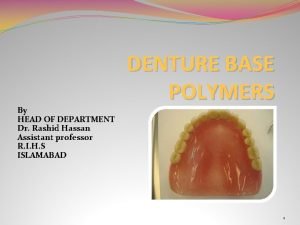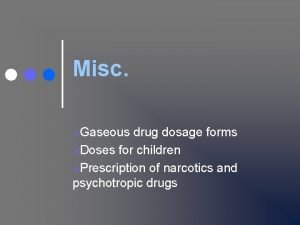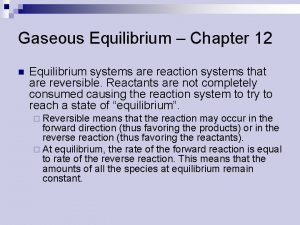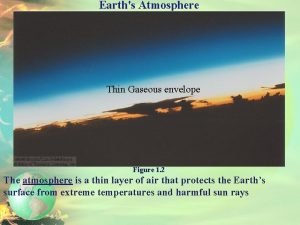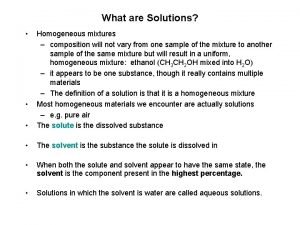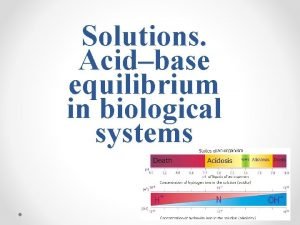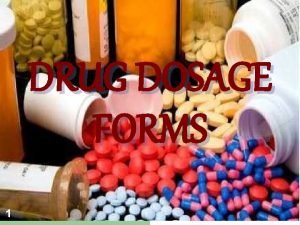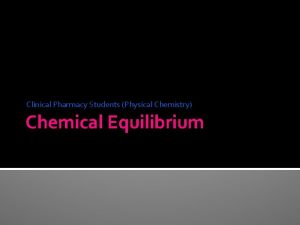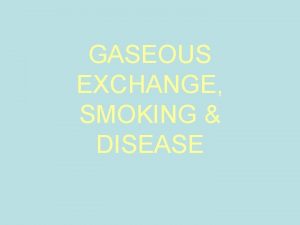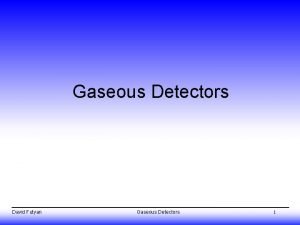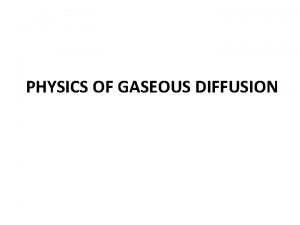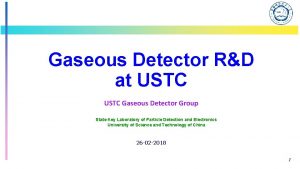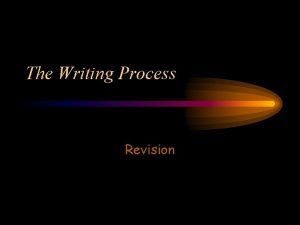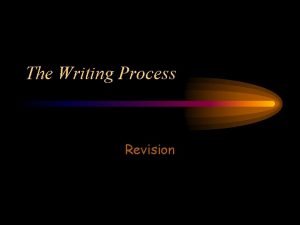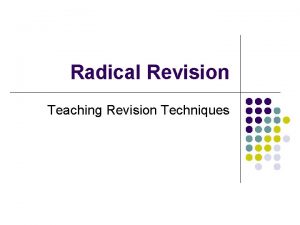Gaseous Exchange and Exercise Revision The Gaseous Exchange



















- Slides: 19

Gaseous Exchange and Exercise Revision

The Gaseous Exchange System • The gaseous exchange system is adapted to: • Clean and warm the air that enters during breathing • Maximise the surface area for diffusion of oxygen and carbon dioxide between the blood and atmosphere • Minimise the distance of this diffusion • Maintain adequate gradients for this diffusion

Lungs • The site of gaseous exchange • Present a huge surface area to the air that flows in and out • Found in the thoracic (chest) cavity surrounded by an airtight space between the pleural membranes • Space contains a small quantity of fluid to allow friction-free movement of the diaphragm and ribs

Trachea, Bronchi and Bronchioles • Leading from the throat to the lungs is the trachea • At the base of the trachea are two bronchi (singular: bronchus) which subdivide forming a “bronchial tree” in each lung • Cartilage in the trachea and bronchi keeps these airways open and air resistance low • Cartilage also prevents them from collapsing or bursting as the air pressure changes during breathing


Trachea, Bronchi and Bronchioles • In the trachea there is a regular arrangement of C shaped rings of cartilage • In the bronchi there are irregular blocks of cartilage instead • The small bronchioles are surrounded by smooth muscle which can contract or relax to adjust the diameter of these tiny airways • During exercise they relax to allow a greater flow of air into the alveoli- the absence of cartilage makes these adjustments possible

Using the following words, explain how air is warmed up and cleaned in the gaseous exchange system (8)

As air flows through the nose and the trachea it is warmed to body temperature and moistened by evaporation from the lining, protecting the lungs from dessication (1) Particles larger than about 5 -10 µm are caught on the hairs inside the nose and the mucus lining the nasal passages and other airways (1) Mucus is produced by the goblet cells of the ciliated epithelium in the trachea and bronchi (1) The upper part of each goblet cell is swollen with mucin droplets which have been secreted by the cell (1) Mucus is a slimy solution of mucin, which is composed of glycoproteins with many carbohydrate chains that make them sticky and able to trap inhaled particles (1) Some chemical pollutants, such as sulphur dioxide and nitrogen dioxide, can dissolve in mucus to form an acidic solution that irritates the lining of the airways (1) Ciliated cells lie between the goblet cells. The continual beating of the cilia carries the mucus up towards the larynx at about 1 cm per minute (1) Macrophages (phagocytic white blood cells patrol the surface of the airways scavenging small particles like bacteria which help to keep the lungs free from infection (1)

Alveoli • At the end of the pathway between the atmosphere and blood stream • Very thin epithelial lining • Surrounded by many blood capillaries carrying deoxygenated blood • Short distance between air and blood means that oxygen and carbon dioxide can be exchanged by efficiently by diffusion

Alveoli • Alveolar walls contain elastic fibres which stretch during breathing • And recoil during expiration (breathing out) to help force air out • Elasticity allows alveoli to expand according to the volume of air breathed in • When fully expanded, the surface area available for diffusion increases

Breathing Rate and Heart Rate • As the body varies its activity, the rate of oxygen required by the cells varies • The rate of oxygen supply to cells is determined by the rate and depth of breathing and the rate at which it is pumped around the body

Breathing Rate and Depth • At rest we need to ventilate our lungs with about 6. 0 dm 3 of air per minute • About 0. 35 dm 3 of new air enters the alveoli with each new breath- this is only about one seventh of the total volume of air in the alveoli • This means that large changes in the composition of the air in the alveoli never occur

Breathing Rate and Depth • It is impossible to empty the lungs completely- even when the chest is compressed during forced exhalation, about 1 dm 3 of air still remains • This is called the residual volume • A much larger volume remains in the lungs after breathing out normally

Exercise • As exercise becomes harder, the depth of breathing increases • The effect of exercise on breathing is measured by calculating the ventilation rate • This is the total volume of air moved into the lungs in one minute • Calculated as: tidal volume x breathing rate • Tidal volume = the volume of air breathed in and then out in a single breath

Pulse Rate • When the heart rate contracts, a surge of blood flows into the aorta and the pulmonary arteries under pressure • The volume of blood pumped out from each ventricle during each contraction is the stroke volume • The total volume pumped out per minute is the cardiac output

Pulse Rate • The surge of blood distends the arteries, which contain elastic tissue • The stretch and subsequent recoil of the aorta and arteries travels as a wave along all the arteries • This is the pulse. The pulse rate is identical to the heart rate • It is counted for 30 s then doubled for beats per minute

Exercise and Rest • At rest the cardiac output is about 5 dm 3 of blood per minute • This is achieved by either a large stroke volume with a low pulse rate or a small stroke volume with a high pulse rate • However, it is more efficient to pump slowly as the heart uses less energy to do this than when pumping at a high rate

Exercise and Rest • During exercise, the heart rate increases providing more oxygenated blood to tissues • If the resting pulse is low and the stroke volume high, only a small increase in pulse is necessary to achieve the required blood supply • People who are physically fit often have a low resting pulse rate

Blood Pressure • Systolic Pressure • • • The maximum arteriol pressure during the active stroke The pressure at which the blood leaves the heart through the aorta As the heart relaxes, the pressure in the left ventricle falls, so that the high pressure in the aorta closes the semilunar valve Elastic recoil of the aorta and the main arteries provides a head of pressure to maintain a steady flow of blood in the arteries towards the capillaries • • Diastolic Pressure • • The minimum pressure in the arteries The value of the pressure reflects the resistance of the small arteries and capillaries to blood flow, and therefore the load against which the heart must work If the resistance is high, so is the pressure If the arteries harden, they will not stretch very well, increasing the pressure • •
 Gaseous exchange in protozoa
Gaseous exchange in protozoa Gas exchange in worms
Gas exchange in worms Gaseous exchange in animals
Gaseous exchange in animals Gaseous exchange grade 11 practical
Gaseous exchange grade 11 practical The earthworm
The earthworm Active and passive vocabulary
Active and passive vocabulary My very excited mother planets
My very excited mother planets Inorganic gaseous pollutants of air
Inorganic gaseous pollutants of air Inorganic gaseous pollutants of air
Inorganic gaseous pollutants of air Gaseous state chapter
Gaseous state chapter Granular porosity denture
Granular porosity denture Inhalanda
Inhalanda Gaseous equilibrium
Gaseous equilibrium Gaseous envelope of the sun
Gaseous envelope of the sun Gas and liquid solution example
Gas and liquid solution example Phosphate buffer system equation
Phosphate buffer system equation Types of dose
Types of dose At 500 k one mole of gaseous oncl
At 500 k one mole of gaseous oncl Real exchange rate vs nominal exchange rate
Real exchange rate vs nominal exchange rate Voluntary exchange
Voluntary exchange
